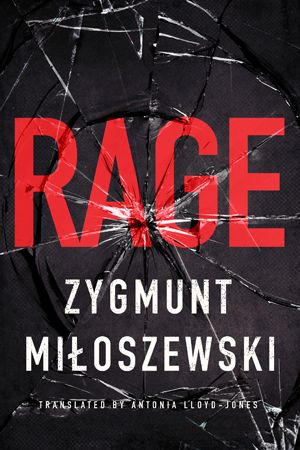 Written by Zygmunt Miloszewski, translated by Antonia Lloyd-Jones — East European characters are plentiful in Western crime novels – usually as villains – and it is past the point of being a cliche. However, we don’t see many crime novels translated from that part of the world. This is only the second example of Polish crime fiction to appear on our site after 21:37 by Mariusz Czubaj, and we’d certainly love to see more of it. Rage offers an excellent opportunity to view a Poland emerging from its Soviet dominated past to become a modern European country, through the lens of crime fiction.
Written by Zygmunt Miloszewski, translated by Antonia Lloyd-Jones — East European characters are plentiful in Western crime novels – usually as villains – and it is past the point of being a cliche. However, we don’t see many crime novels translated from that part of the world. This is only the second example of Polish crime fiction to appear on our site after 21:37 by Mariusz Czubaj, and we’d certainly love to see more of it. Rage offers an excellent opportunity to view a Poland emerging from its Soviet dominated past to become a modern European country, through the lens of crime fiction.
Teodor Szacki is a prosecutor in the pretty city of Olsztyn. Pretty, because during periods of its history, its German occupants created some wonderful architecture there. Pretty, because within the city there are 11 lakes, which cast up mist and fog on cold mornings that help with the book’s increasingly morbid atmosphere.
Author Zygmunt Miloszewski gets that morbidity going quickly, with an opening scene in which a man is strangling his young victim. It’s hard to take a life with your bare hands, the man discovers. Then we slip back in time 10 days, presumably to find out how we’ve ended up in a dark house with one man and one corpse.
This is the dry-witted Szacki’s third outing – he previously appeared in Entanglement and A Grain of Truth, both of which have been translated. Prosecutors in Poland play a role more similar to CID detectives than legal eagles, it seems, and Szacki’s case begins as he’s called out following the discovery of a skeleton in a vault beneath the streets that’s connected to a students’ hall of residence occupied. Nobody’s been in the vault for ages, however, and at first they think the bones belong to a German, left there during the Nazi retreat at the end of the war. But the skeleton is too clean, too perfect, so Szacki sends it to a university department where one Dr Frankenstein – yes, really – and his assistant perform a series of tests and determine that the body was stripped of its flesh using the alkali substance, lye.
As Szacki, his junior Falk and the policeman Beirut investigate the skeleton, the action shifts every so often to a home in the city where a woman is being abused by her husband. She even comes to Szacki with a complaint, but because the abuse isn’t the kind that leaves physical marks he dismisses her concerns. Later, she’s found in her home with a grave head wound, her toddler sitting next to her covered in blood and spilled milk. When her husband turns up, he can’t talk, and it turns out that something was rammed down his throat so hard his vocal cords have been sheared off.
It’s all very intriguing and the author builds an enthralling mystery around the skeleton, and what appears to be a vigilante on a campaign to kill and maim domestic abusers. It’s a topic coming to greater prominence in Poland as society there changes and begins to recognise some of the things that just weren’t talked about during the bad old days.
There’s a wonderful shift of perspective as we discover the beaten woman through the eyes of her little boy, before Szacki and the other police arrive. Like Jo Nesbo, Miloszewski has fun dropping side characters into the narrative and actually telling part of the story through them before returning to Szacki’s viewpoint. This gives his storytelling some imaginative zip – it’s very enjoyable in places.
Szacki’s personal life and his outlook are integral to the story, though this element of the book doesn’t sparkle quite so much. His family will play an important role in the outcome, but you’ll be wondering throughout the middle third just why so much attention is given to his live-in girlfriend Zenia, and his teenage daughter Hela. Like so many fictional detectives of his ilk – Wallander, Simonsen, Morck, Erlendur, Sejer – he’s an introspective man, but his cynicism and anger come across as so acidic they’ld neutralise the lye used to kill the first victim in an instant. Despite the family dimension, it makes our man difficult to like, difficult to respect, and sometimes difficult to believe.
As the pieces fall into place, Szacki completes his catharsis – it’s all to do with his internal rage – but to do so he has to face a double-twist as the mystery concludes. It’s cleverly done and you may not see these twists coming. They give the book a grim yet much-needed lift towards the end.
Amazon Crossing
Print/Kindle
£3.99
CFL Rating: 3 Stars









